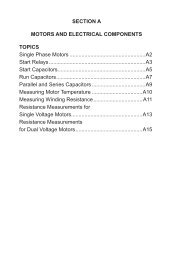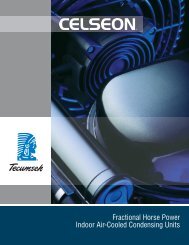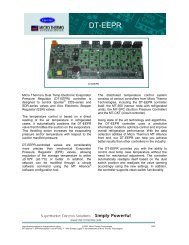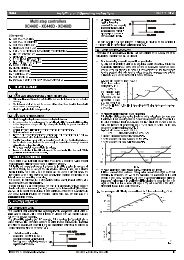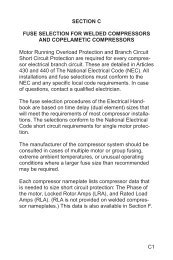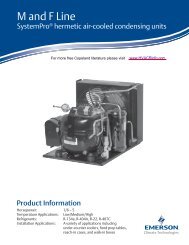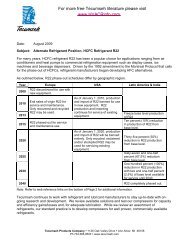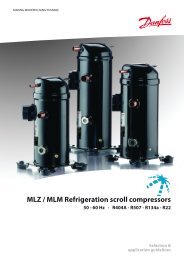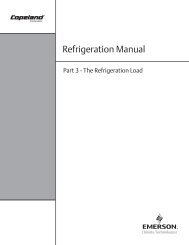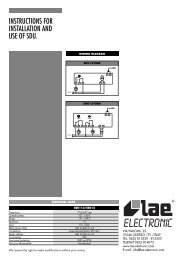provided in the event the defrost cycle for some reasonis abnormally prolonged.RELAYSA relay consists of a set of contacts together with amagnetic coil mechanism which controls the contactposition. The contacts may be normally open or normallyclosed when not energized, <strong>and</strong> a given relay may havefrom 1 to 5 or more sets of contacts. When the coil isenergized, the contacts reverse their action <strong>and</strong> makeor break various circuits as desired.A relay may be used to control a large amperage load bymeans of a pilot circuit, to allow interlocking of controlson separate circuits, or for any application where remotecontrol is required.Most relays are of the potential type, <strong>and</strong> are actuatedwhen the coil is energized with the proper voltage.Current relays are actuated by a sufficient currentflowing through the relay coil, <strong>and</strong> are normally usedwhen it is desirable to make or break a circuit when alarge change in current flow occurs. These are used insingle phase motor starting circuits, <strong>and</strong> occasionallyin safety circuits.An impedance relay is similar to a normal potential relayexcept that the coil is wound so as to create a highresistance to current passage. When wired in parallelwith a normal relay, the high impedance (resistance)of the relay will shunt the current to the normal circuit<strong>and</strong> the impedance coil will be inoperative. If the normalcircuit is opened <strong>and</strong> the current must pass through theimpedance relay, the relay coil will be energized <strong>and</strong> theimpedance relay will operate. The voltage drop across therelay coil is so large that other magnetic coils in serieswith the impedance coil will not operate because of theresulting low voltage. Impedance relays are frequentlyused for safety lock-out circuits in the event of a motorprotector trip.TIME DELAY RELAYSome relays are constructed with a time delay actionso that the relay must be energized for a predeterminedlength of time before the magnetic coil can actuate thecontacts. The time delay is normally non-adjustable, butrelays are available with varying periods of delay.This type of relay may be required for part winding startmotors; in circuits to prevent short cycling, or for otherspecialized applications.TRANSFORMERSA transformer is an electrical device for transferringelectrical energy from one circuit to another at adifferent voltage by means of electromagnetic induction.Transformers are frequently used in control circuits tostep voltage down from line voltage to a lower controlcircuit voltage. There are no moving parts <strong>and</strong> the actionof the transformer is determined by its coil windings.The transformer output is limited by its size, buttransformers are available for almost any output desiredfrom a tiny alarm bell circuit to the giant transformersused on high voltage power transmission lines.The selection of control circuit transformers can vitallyaffect the performance <strong>and</strong> life of many electricalcomponents in a refrigeration or air conditioningsystem.An inadequate transformer supplying abnormally lowvoltage to the control circuit will result in improperoperation of contactors <strong>and</strong>/or motor starters due tochattering or sticking contacts, burned holding coils,or failure of contacts to properly close. Since any ofthese conditions can cause eventual system failure <strong>and</strong>possible damage to the compressor, control transformersmust be properly sized.Even though a proper size transformer has beenselected, care must be taken to avoid excessive voltagedrop in a low voltage control circuit. When using a 24volt system with a remote thermostat, wire of sufficientcurrent carrying capacity must be installed between thetransformer <strong>and</strong> the thermostat .According to NEMA st<strong>and</strong>ards, a solenoid or contactormust operate satisfactorily at a minimum of 85% of ratedvoltage. Allowing for a line voltage fluctuation of plus orminus 10% which can occur on electric utility systems,the voltage drop of the transformer <strong>and</strong> connecting wiringmust be limited to 5% to insure a minimum of 85% ofrated voltage at the magnetic device.A transformer works on the magnetic induction principle,has no moving parts, <strong>and</strong> normally will have a long <strong>and</strong>trouble free life. However, overloading of a transformerresults in excessive temperatures which will cause rapiddeterioration of the insulation <strong>and</strong> eventual failure of thetransformer coils.A control circuit transformer will not overheat, nor will itssecondary output voltage drop below 95% of its ratedvoltage if:© 1967 Emerson Climate Technologies, Inc.All rights reserved.8-3
1. The continuous VA (volt-amperes) capacity of thetransformer is equal to or greater than any continuousVA load that can occur in the system.2. The inrush VA capacity of the transformer is equal toor greater than the maximum VA load that can occurfor any combination of sealed <strong>and</strong>/or inrush load.(A sealed load is the terminology used to describea component load drawn through closed or sealedcontacts, after the inrush current has returned tonormal operating conditions.)Selection Procedure1. To select the proper transformer, the followinginformation is necessary:a. A list of all components in the control circuit.b. The sealed VA <strong>and</strong> watts for each.c. The inrush VA <strong>and</strong> inrush watts for each.Note: The VA <strong>and</strong> watts of magnetic devices will varywith each manufacturer, so it is necessary to obtainexact information on the components to be used.Since not all of the inrush data is included in catalogs,it will be necessary to contact representatives ofcomponent manufacturers for information whendesigning control circuits.2. The continuous VA requirement is determined bycombining the sealed VA of all components in thecircuit which can be energized at one time.3. The inrush VA capacity of a transformer is determinedby two factors — the VA inrush <strong>and</strong> the inrushload power factor. Each transformer manufacturerpublishes rating charts showing the inrush capacityof each size transformer in terms of the per cent ofrated load at varying secondary output voltages <strong>and</strong>varying power factors. Since output voltages lowerthan 95% are not acceptable, the only variable tobe determined is the power factor.The maximum VA inrush is found by combining theinrush VA that can occur with the maximum sealedVA that can occur simultaneously. To determine theinrush load power factor, divide the maximum inrushwatts by the maximum inrush VA.Examples Of Transformer SelectionFigure 44 is typical of one manufacturer’s curves showingthe inrush capacity of three different transformers at95% of rated output voltage for varying power factors.To illustrate the selection procedure, assume a controltransformer is to be selected from Figure 44 for thefollowing control circuit:Example No.1Sealed Sealed Inrush InrushVA Watts VA Watts1 - 60 amp contactor 25 7 165 1241 - oil pressuresafety switch 25 25 25 251 -10 amp fan starter 8 5 58 12Assume the compressor is cycling on the contactor,<strong>and</strong> the oil pressure safety switch heater element isenergized whenever the compressor oil pressure isbelow 15 psig. The fan starter is used to energize a fancircuit at the same time the compressor is energized.Therefore, the contactor <strong>and</strong> the fan starter would be acontinuous load, <strong>and</strong> the inrush load would be the inrushVA of the contactor <strong>and</strong> the fan starter, plus the heaterload of the oil pressure safety switch.A. Continuous VA requirementContactor 25 VAFan Starter 8 VATotal 33 VAAny transformer with a rating of 33 VA or more wouldh<strong>and</strong>le the continuous load, so the 60 VA transformeris satisfactory.B. Inrush VA RequirementVA WattsContactor 165 124Fan Starter 58 12Oil PressureSafety Switch 25 25Total 248VA 161 Watts161 WattsPower factor equals 248 VA or .65Although the continuous VA requirement could be metwith the 60 VA transformer shown on Figure 44 it wouldrequire the 140 VA transformer to satisfy the inrush VArequirement, <strong>and</strong> the larger size must be used.Example No.2Assume the same conditions as in Example No.1 exceptthat the compressor has two 60 amp contactors foracross the line operation.(continued on p. 8-6)8-4© 1967 Emerson Climate Technologies, Inc.All rights reserved.



